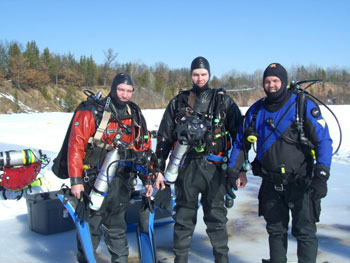 Staying Warm; Diving in Cold Water
Staying Warm; Diving in Cold Water
The debate regarding what is “cold water” and what thermal protection should be worn by a diver, in my opinion, will never end. There are no ‘one size fits all’ answers to these questions. Having dived all around the world in lots of different water temperatures brings me to this conclusion. Some of the waters I dived in when I first started diving seemed extremely warm and I swore I would never need a wetsuit. Six months later, I was in a 3mm full length suit. Six months after that, I was in a 7mm full length with hood. This was just for sport level diving, without the long bottom and decompression times associated with technical dives.
Comfort Tip
It’s quite common to overheat while dressing. A couple of tricks: get your hood wet before putting it on. This makes a big difference in your comfort prior to entering the water. Also, once you get fully dressed, take a dip in the water. Getting wet will help you stay comfortable while putting on the rest of your gear.
– Susan Long, DUI
There are many factors to consider when choosing the proper thermal protection, but one that should never be used is the ego. Divers are known to think they are “warm blooded” and dive with minimal thermal protection. This is a bad choice. Making a decision based on this defies the basics of physics, a diver is submerging himself in a medium that is 800 times denser than air and will draw heat away from the body at an incredible rate, no matter how “warm blooded” you are. Starting from the planning stages of the dive, there are two things to consider: target depth temperature and exposure time at that temperature. If the target depth temperature is cold, another serious consideration comes into play – air temperature while gearing up and exposure to the sun. If the outside weather is warm or hot, divers will tend to under dress for the dive out of fear of overheating, an equal concern for sure. A better solution to overheating at the surface is to time the gearing up with the buddy or dive team so you are ready at the same time and dressing in an area that is out of the sun.
As a diver who dives in cold water, defined by me as anything colder than 24°C / 75°F, with temperatures as low as – 2°C / 29°F, I always choose to dive in a drysuit. The drysuit allows you to adjust your thermal protection by the undergarments you use and, in some cases, you can adjust the thermal protection on your upper and lower half with two piece undergarments. There are two big benefits to using a drysuit: no cold water shock and, after the dive is over, your skin is dry when you take the suit off. Thus, you avoid evaporational cooling. For longer dives where water temperature is on the warmer end of the thermometer, and especially during decompression stops, drysuits can present a bit of a problem: the diver can start to overheat. One way to avoid this is to take off your gloves and un-zip your hood (if the hood is equipped with a rear zipper).
Other options for staying warm are wetsuits and semi-drysuits. Both have some very distinct advantages over drysuits. First there is cost; any form of wetsuit tends to be less expensive than a drysuit. You also do not have to worry about leaks, which could end a dive before it even begins or cause you to terminate the dive before the planned turn time. Both wet and semidry suits provide excellent thermal protection, and for those long deco stops in warmer water give you the advantage of unzipping the suit to allow water in so you don’t overheat. A downside to wet or semidry suits is that the neoprene compresses at depth, which reduces the thermal protection properties of the suit, causing you to get cooler quicker.
Staying warm during the dive is vital to the comfort of the diver, as well as his safety. It is commonly accepted that being cold during a dive can increase the risk of decompression sickness. Listen to your body and decide what a comfortable temperature is for you. Don’t accept what is “common knowledge,” just use it as a starting point. Also, keep in mind that the older a suit gets, the less thermal protection it provides. This is especially true in wetsuits and neoprene drysuits, so what kept you warm five years ago may not work now.
Contact SDI TDI and ERDI
If you would like more information, please contact our World Headquarters or your Regional Office.
Tel: 888.778.9073 | 207.729.4201
Email: Worldhq@tdisdi.com
Web: https://www.tdisdi.com
Facebook: www.facebook.com/TechnicalDivingInt

 Staying Warm; Diving in Cold Water
Staying Warm; Diving in Cold Water